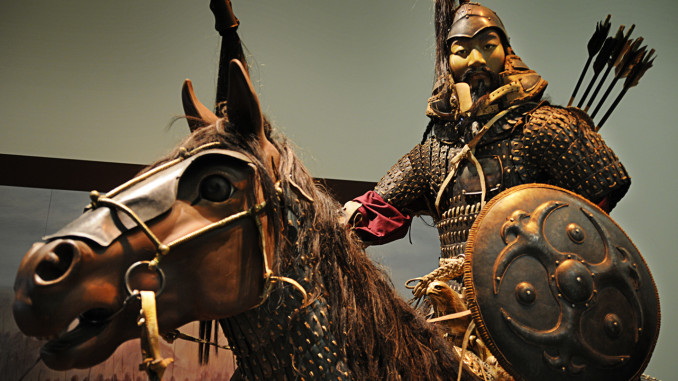
(Note: all bibliographic information, including the works cited page, has been removed from this essay)
During the thirteenth and fourteenth centuries, trade flourished under the rule of men who originated as tribal, nomadic barbarians. Their union began a rise of economic prosperity and respect towards merchants. They influenced many territories spanning across various terrains. The Mongol Empire created an unprecedented network of trade across Eurasia and positively influenced the economies of the areas it conquered.
The rise of the Mongol Empire rose with a time of havoc and disorder within Eurasia. While they began to join together, the nomadic barbarians from the steppes treated local populations brutally by pillaging and burning cities to the ground. Sa’di, a Persian poet who lived during this time wrote, “After the Mongols’ invasion, the world seemed as tangled as the hair of an Ethiopian. Men were like wolves.” But this period of destruction can also be labeled as organized territorial expansion. Destroying cities or populations that refused to surrender was “one of the more successful tactics employed by the Mongols” because it showed unwavering strength as well mercy and leniency for those who chose to allow Mongol conquest. Also, “in addition to intimidation tactics, the rapid expansion of the Empire was facilitated by military hardiness (especially during bitterly cold winters), military skill, meritocracy, and discipline.”
Genghis Khan was a man who united the nomadic tribes of the Mongolian plateau and continued on to conquer huge chunks of central Asia and China, creating the most extensive land-based empire yet. He organized his men and developed new complex military strategies such as siege warfare, feint retreat, and an extensive cavalry. The Mongols also captured Chinese engineers and built siege engines that aided attacks which required passing through city walls or fortifications. Their methods of gaining territory were effective and humane only towards their own army; Mongol administration established a system of supply distribution that allowed each section enough to last them throughout their conquests. Historian Mary Hull writes:
. . . They were a formidable sight. Each tumen [an army unit of 10,000 soldiers] was equipped with packhorses who walked behind the ranks carrying additional equipment and weapons. In the rear of the army, behind the siege of engines and reserves, was the main baggage train of camels and wagons loaded with supplies and equipment. Fully assembled tents, mobile yurts, were also carried on carts. Following the carts were the flocks of sheep and goats that provided food and milk for the army.
The organization of the Mongols as they began to form one the largest land empires in history was characterized by fierceness and the utilization of innovative military tactics.
While the Mongols conquered people, they took over the Silk Road and turned it into a unified trade route of cultural diffusion and assimilation. The Mongols “prized their commercial and trade relationships with neighboring economies” and created the first empire that unified the majority of Eurasia. Their presence in China was particularly influential as it culture-shocked the Chinese and their traditional ways. In China, merchants had been at the bottom of the Chinese hierarchy but when the Mongols took over, merchants were regarded very highly. The Mongols also got rid of “confiscatory taxation” which the merchants had to face throughout many Chinese Dynasties. Another change that Mongols made was the creation of merchant associations, called Ortoghs. These allowed merchants to “pool their resources to support a single caravan”; losses, risks, and profits would be shared between all of the merchants involved and “no single merchant would be put out of business.” Merchants involved in an Ortogh also qualified for loans provided by the Mongols. During the Yuan dynasty, The Mongols also increased the amount of paper money in circulation and guaranteed the value of that paper money in precious metals.
All of these changes and improvements not only facilitated trade, but also created so much economic prosperity and peace that historians now regard this time as the Pax Mongolia. John Masson Smith Jr., Professor at University of California, Berkeley, wrote an essay titled “The Mongols and the Silk Road” which was full with examples of the prosperous times of the Pax Mongolica and the cultural exchanges that took place across the Silk Road. He wrote:
Chinese weavers were sent to Samarkand to collaborate with the local Muslim weavers, and Muslim weavers who were specialists in cloth-of-goldwere brought to China. Wealthy Mongols invested in these enterprises, and in the vending of their products, forming commercial associations (ortaqs) with merchants experienced in transporting over the Silk Road . . . Such Mongols could also arrange for their merchant partners to use the facilities of the yam to obtain provisions, fresh animals and secure lodgings for their caravans. In the century, approximately, of Mongol rule in Eurasia, the Silk Road flourished as never before.
Along with the good that came across the Silk Road was the bad. Inadvertently, the Mongols were also the source of a new wave of epidemics that swept through much of Europe in the fourteenth century. The Black Death originated in Asia and spread across the Silk Road to Europe, where it devastated the population and caused economic hardship. This shows the strong and complex network that the Mongols created between Asia and Europe.
The territories that the Mongols conquered and added to their empire varied drastically, but this did not stop the Mongols from gaining control and implementing their rule. The most fundamental area that the Mongols gained control of was China during the Song Dynasty. Kublai Khan sought to conquer China and defeat the Song Dynasty for three reasons. First, the land of southern China was much more arable than the land in the north, which was already under Mongol control. Kublai Khan aimed to conquer this territory to increase the food production of the empire. A second reason was that China’s coastal ports were very valuable. They would increase the empire’s foreign trade and increase the wealth of the empire. Kublai Khan also feared military revolts from the Song if he didn’t gain control of them. The Mongols left the administrative system the same, but did make a few changes within the empire. For example, Kublai Khan established a postal-service system that created efficient movement of information and provided rest areas for travelers and merchants. They also built many roads, which were mainly used to “facilitate the Mongols’ rule over China.”
Another area that the Mongols conquered and influenced was modern-day Iran. Historian George Lane writes, “The establishment of the Il-Khanate dynasty in Iran in the mid-thirteenth century negates all the myths and tales of irredeemable Mongol barbarism and their rule as a blot on an ancient civilization’s history.” He also discusses how this time was “a period of Iranian cultural renaissance.” The positive changes that the Mongols brought to the areas that they gained control of are numerous. In Persia, under the Mongols, traders were given higher tax breaks and benefits in an effort to “promote commerce.” This shows how the Mongols strived to “provide additional assistance to traders.” Farther north, the Golden Horde’s capital, Sarai, prospered and thrived under Mongol rule. The famous explorer, Ibn Battuta, wrote, “The city of al-Sara [Sarai] is one of the finest of cities, of boundless size . . . choked with the throng of its inhabitants, and possessing good bazaars and broad streets.” These examples emphasize the achievements of the Mongol Empire and their ability to follow territorial expansion with economic prosperity.
During the thirteenth and fourteenth centuries, there was a time of advanced networking and prosperous trade across the entirety of Eurasia, much of which was facilitated by the Mongol Empire. The Mongols were not only religiously tolerant, but were also able to accept the differences of other cultures and assimilate them with their own. As Genghis Khan, the Great Khan, said, “Be of one mind and one faith, that you may conquer your enemies and lead long and happy lives.”
